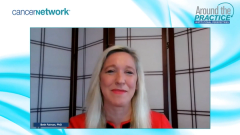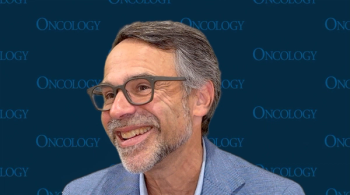
Optimal Selection of Therapy for Patients With Transplant-Eligible NDMM
A focused discussion on navigating the treatment armamentarium for patients with transplant-eligible newly diagnosed multiple myeloma.
Episodes in this series

Transcript:
Beth Faiman, PhD, MSN, APN-BC: The DETERMINATION study suggests that there’s a role in transplant, but were there patients in that study who had high-risk characteristics similar to this patient?
Louis Williams, MD: There were. The high-risk patients in DETERMINATION had a profound improvement in PFS [progression-free survival]—about 55 months vs 17 months. Those are transplanted patients against patients who went on to consolidation with RVd [lenalidomide, bortezomib, dexamethasone], so there’s absolutely a role, like in many other trials. Unfortunately, we’re relying on subgroup analyses in small numbers, about a quarter of the patients, so it’s hard to definitively say, but yes, there’s absolutely a role for transplant in the high-risk patient population.
Beth Faiman, PhD, MSN, APN-BC: He had a wonderful response in terms of improvement in free light chains over time, so that’s clearly something we can consider. Let’s talk about the GRIPHON study. Dr Khouri, tell us about the GRIFFIN study.
Jack Khouri, MD: The GRIFFIN study was a randomized phase 2 study that studied the addition of daratumumab to the standard of care of bortezomib, lenalidomide, and dexamethasone. The study gave patients induction therapy with 4 cycles of the quadruplet vs the triplet, and then everybody went on to have a stem cell transplant. After that, there was another randomization to daratumumab with lenalidomide maintenance vs lenalidomide alone. The study found that the addition of daratumumab improved the stringent complete remission rate. Obviously, more individuals got stringent complete remission with the addition of daratumumab. Another major finding from this study was that MRD [minimal residual disease] rates were deeper with the addition of daratumumab, and that kept deepening over time. The other major finding was that the progression-free survival was better with the addition of daratumumab.
Beth Faiman, PhD, MSN, APN-BC: That’s excellent. Let’s talk about the MASTER study. I think you have firsthand experience with that concept.
Sandra Mazzoni, DO: The MASTER study is a very different concept. It involves a lot of consolidation. The MASTER study involves daratumumab, carfilzomib, Revlimid [lenalidomide], and dexamethasone. All these patients were transplant eligible and newly diagnosed. It was a single arm, so everyone is getting this therapy on this study. They would get 4 cycles of this therapy and then go for transplant. The big thing that they were monitoring was MRD based on next-generation sequencing. Next-generation sequencing was done after the 4 cycles prior to transplant. It was then done at intervals after transplant in the consolidation phase. Based on that, the big question they were trying to ask is if there’s a role for being able to discontinue therapy in certain patient populations. If patients had 2 consecutive time points of MRD negativity, those patients were going to be eligible for discontinuation of therapy.
Beth Faiman, PhD, MSN, APN-BC: That’s such a impactful study. It goes back to carfilzomib. We selected daratumumab based on the timing, patient characteristics, and physician preference. But in what individuals would you consider carfilzomib instead of bortezomib, for example? Dr Khouri?
Jack Khouri, MD: If somebody has peripheral neuropathy, I’d definitely consider carfilzomib instead. That would be the main reason.
Beth Faiman, PhD, MSN, APN-BC: In our experience we see many patients at Cleveland Clinic with heart disease and cardiac amyloidosis, and patients can receive carfilzomib safely. What’s your baseline, Dr Williams? Do you do ECG [electrocardiogram] and echocardiogram before carfilzomib? Do you prefer that they have it within 6 months? Let’s say you’re starting somebody newly diagnosed on carfilzomib with high-risk disease. What would you do?
Louis Williams, MD: In terms of assessing cardiac risk?
Beth Faiman, PhD, MSN, APN-BC: Assessing cardiac risk.
Louis Williams, MD: I try to have at least a transthoracic echocardiogram and an ECG done. The most important part is looking into their cardiac history. Those are the minimum 3 things we try to do.
Beth Faiman, PhD, MSN, APN-BC: For a 52-year-old who has no prior medical history, you’d think he’s probably OK. That could have been a consideration with them. What do you think about NT-proBNP in any of these patients? That can be elevated in kidney disease on dialysis. Would that be a biomarker that you’d assess to make sure this patient didn’t have amyloidosis? Dr Mazzoni, would you biopsy this kidney? Even though his Congo red was negative in his marrow, he still has unexplained disease.
Sandra Mazzoni, DO: Yes. That’s a question that we all debate quite a bit, and we’re fortunate that we have a big group of renal experts who we work closely with. It’s a conversation we have with them. If we don’t have a clear-cut answer, and they’re not responding and their renal function isn’t improving, that would increase our reason to do a kidney biopsy at that point.
Beth Faiman, PhD, MSN, APN-BC: Absolutely. We have great experts at the Cleveland Clinic to interpret these pathological findings. I wish we could talk about MGRS [monoclonal gammopathy of renal significance] because that’s a passion for all of us as well, but we don’t have time. That pretty much covers it.
The other thing I wanted to ask about was VTE [venous thromboembolism] risk stratification. At the Cleveland Clinic, we reported early on about thalidomide, increased risk of thrombosis, and the role of aspirin in VTE prevention; subsequent studies supported that. Now we have different risk modeling. Dr Khouri, you have a lot of experience, and you validated the IMPEDE VTE.
Jack Khouri, MD: We validated the IMPEDE VTE risk score, and that’s what I use in my clinic. There are 3 risk categories: low, intermediate, and high risk for VTE. What to do when you have somebody with low risk vs high risk? We still don’t know. I favor certain medications vs others depending on their risk of clotting.
Beth Faiman, PhD, MSN, APN-BC: Do you put everybody on carfilzomib-based treatment and an IMiD [immunomodulatory drug], like lenalidomide? Our practice has changed rivaroxaban. The [Memorial] Sloan Kettering [Cancer Center] researchers reported that.
Jack Khouri, MD: That’s right.
Beth Faiman, PhD, MSN, APN-BC: You specialize in benign hematology as well, Dr Mazzoni. What are your thoughts on rivaroxaban vs apixaban for VTE prophylaxis, and why?
Sandra Mazzoni, DO: Sometimes it’s out of my hands. Sometimes it has to do with insurance. A low-dose DOAC [direct oral anticoagulant]—Eliquis [apixaban] or Xarelto [rivaroxaban]—is superior to aspirin, especially in these patients. There are a lot of data that carfilzomib and IMiDs have an increased risk.
Jack Khouri, MD: Lenalidomide together, yes.
Sandra Mazzoni, DO: For those patients, especially in the long term, we’ve got to get a real-world study looking at all comers for 6 months of therapy. That’s the window where you have the highest risk.
Beth Faiman, PhD, MSN, APN-BC: Excellent. This has been a great discussion on newly diagnosed myeloma. Any additional thoughts on this case? Are there things you’d do differently from what we discussed? Do you have any clinical pearls for the audience?
Jack Khouri, MD: Yes. The patient is on dialysis, and dialysis is not a contraindication for stem cell transplantation. From large cohort analyses, we know that that stem cell transplant is safe for patients on dialysis, and it should not be a contraindication for transplant.
Beth Faiman, PhD, MSN, APN-BC: Excellent. That’s why we put him as a transplant-eligible case study. But then with that high-risk disease, what are your thoughts?
Jack Khouri, MD: On transplant?
Beth Faiman, PhD, MSN, APN-BC: Would you do CAR [chimeric antigen receptor] T-cell therapy or a more innovative therapy, or high-dose melphalan in a patient with dialysis in those?
Jack Khouri, MD: They’re both feasible. CAR T-cell therapy should be on clinical trial. Stem cell transplant is my way to go for patients like that. As Dr Williams said, based on the DETERMINATION study, especially for high-risk patients, stem cell transplant is 1 of the best things we can offer in the frontline setting.
Beth Faiman, PhD, MSN, APN-BC: Excellent. Final thoughts?
Louis Williams, MD: It’s an unfortunate scenario and a typical 1. More study is definitely needed for the high-risk patient population. I love to see clinical trials dedicated to answering some of these questions a little better so we don’t have to rely on the subgroups. That’s in the future.
Beth Faiman, PhD, MSN, APN-BC: Excellent.
Transcript edited for clarity.
Newsletter
Stay up to date on recent advances in the multidisciplinary approach to cancer.


















































































